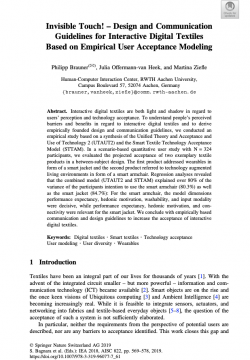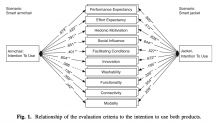
Abstract
Interactive digital textiles are both light and shadow in regard to users’ perception and technology acceptance. To understand people’s perceived barriers and benefits in regard to interactive digital textiles and to derive empirically founded design and communication guidelines, we conducted an empirical study based on a synthesis of the Unified Theory and Acceptance and Use of Technology 2 (UTAUT2) and the Smart Textile Technology Acceptance Model (STTAM). In a scenario-based quantitative user study with N = 324 participants, we evaluated the projected acceptance of two exemplary textile products in a between-subject design. The first product addressed wearables in form of a smart jacket and the second product referred to technology augmented living environments in form of a smart armchair. Regression analyses revealed that the combined model (UTAUT2 and STTAM) explained over 80% of the variance of the participants intention to use the smart armchair (80.3%) as well as the smart jacket (84.7%): For the smart armchair, the model dimensions performance expectancy, hedonic motivation, washability, and input modality were decisive, while performance expectancy, hedonic motivation, and connectivity were relevant for the smart jacket. We conclude with empirically based communication and design guidelines to increase the acceptance of interactive digital textiles.
Brauner P., Offermann-van Heek J., Ziefle M. (2019) Invisible Touch! – Design and Communication Guidelines for Interactive Digital Textiles Based on Empirical User Acceptance Modeling. In: Bagnara S., Tartaglia R., Albolino S., Alexander T., Fujita Y. (eds) Proceedings of the 20th Congress of the International Ergonomics Association (IEA 2018). IEA 2018. Advances in Intelligent Systems and Computing, vol 822. Springer, Cham.
Related Project(s):

